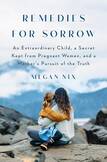Review: A mother’s thoughtful memoir delves deep
Doctor’s appointments can feel rushed and impersonal, with the clinician failing to make eye contact as they type the patient’s symptoms into a computer. What difference could be made in the quality of care and overall medical knowledge if doctors instead sought to listen to the patient’s entire story? This is the idea behind narrative medicine, a field that Rita Charon helped establish three decades ago, implementing a curriculum at Columbia University and publishing books on the subject. The practice of narrative medicine has spread, even though its humanist approach is at odds with the bottom-line ethos of corporatized medicine.
In Megan Nix’s thoughtful and moving debut Remedies for Sorrow, she reflects on the doctors who took the time to listen to her entire story as she sought answers about her daughter’s disabilities, in contrast to those who seemed rushed, incurious or too egotistical to accept that there were ailments they knew little about. “Narrative is prevention,” Nix writes.
Remedies for Sorrow delves into the medical literature to construct a history of congenital CMV (cytomegalovirus), a little-known virus that causes birth defects.
Nix’s book is ostensibly a memoir, but confining Remedies for Sorrow to one genre seems too restrictive for what this expansive and enlightening book accomplishes. It tells the story of Nix and her family, yes, but it also delves into the medical literature to construct a history of congenital CMV (cytomegalovirus), a little-known and astonishingly prevalent virus that causes birth defects. She roves into theology and philosophy, gathering insights from Thomas Merton, Thomas Aquinas, Susan Sontag, C. S. Lewis and Patricia Hampl, to name a few thinkers whose wisdom Nix cites and reflects on.
The book could be classified as journalism for the way Nix spends time with families whose children have been disabled or died from CMV and conveys these lives in all their particular suffering and grace. It is also a work of advocacy, as Nix informs people about CMV and pushes legislators to enact laws that could enable its prevention and detection. And it is a testament of faith, as Nix synthesizes all these threads into a beautiful meditation on what it means to live in a world where suffering befalls the most innocent.
As Remedies for Sorrow opens, Nix gives birth to Anna, her second child, who is born silent and with a low birth weight for her gestational age. Anna fails her hearing test, and the doctors tell Nix not to worry, but she senses something is wrong. “There’s something different, even foreign, about this child,” Nix writes, “like she might contain something that isn’t quite ours.” At first, Nix is reluctant to press for answers. “I respect doctors, I tend to be obedient to authority, and I didn’t yet think of motherhood as an authority of its own,” she writes.
After Anna fails another hearing test when she is a few weeks old, Nix finds a doctor who suggests they test her for congenital CMV. At this point Nix, like surely many readers of the book, has never heard of CMV. When Anna tests positive for it, Nix begins to learn everything she can. “CMV is a common virus that stays in your system forever, like chicken pox,” a doctor explains. “If you caught it when you were pregnant, it wouldn’t harm you. But if it crosses the placenta, it can pose serious challenges for a fetus because they’re in the midst of development.”
While doctors routinely inform pregnant women about the risks of other uncommon causes of birth defects, according to one source Nix cites, 91 percent of American women have never heard of CMV. This is shocking, given that, “around 40,000 American babies are born each year with CMV, of whom 6,000 to 8,000 will end up with lifelong disabilities. Children disabled by congenital CMV outnumber children disabled here by any other congenital condition or disease, including Down syndrome, spina bifida, cystic fibrosis, and pediatric HIV.”
Children born with CMV can experience a number of problems, from hearing loss to blindness to early death. Some calamities can be averted by quick detection and treatment. There’s so little awareness of CMV, and so little testing done for it, however, that many people never learn that CMV is the likely cause of their child’s disabilities. CMV is a virus, so its spread can be mitigated by the various virus-avoidance methods we’ve all learned since the pandemic, from hand washing to mask-wearing to refraining from eating your sick toddler’s leftovers.
Alongside the medical mystery Nix pursues, she places her own spiritual journey.
However, as Nix discovers, CMV is “a condition the medical world has contested disclosing to pregnant women for the last seventy-some years.” Why would doctors withhold this crucial information from patients? Nix tries to get to the root of this. Are doctors afraid women will neglect their toddlers if they learn these germ-prone kids are one of the primary risks for passing CMV to the fetus? Do they think women can’t handle the truth? Or does the medical system lack the resources for testing and care that reducing the rate and severity of CMV in America would require? The answer seems to be all of the above. “The truth I’m after is proof that women can handle the facts—no matter how inconvenient, no matter how complex,” Nix writes.
Alongside the medical mystery Nix pursues, she places her own spiritual journey. Nix was raised Roman Catholic, and her brother David is a traveling priest who goes by “Padre Peregrino.” David encouraged Nix to visit a Byzantine church in Denver, and while there, Nix reflects, “Something here felt authentic, ancient, laid bare.” A striking man named Luke was singing in the choir that day. He introduced himself at a potluck, and the rest is history. Nix married Luke, an easygoing man who spends summers in Alaska fishing nonstop, earning enough to support the family for the rest of the year.
Remedies for Sorrow was titled after five activities St. Thomas Aquinas detailed in his Summa Theologica to help people overcome the blues. Nix divides her book into sections named after Aquinas’s theses: weeping, contemplation, company, pleasure and caretaking. When Nix reaches an impasse in seeking answers and assistance from the medical and scientific community, she turns toward her faith:
Though my prenatal care providers hadn’t prepared me for the ubiquitousness of illness, my religion should have. In scripture, God is referred to constantly as a healer; in Orthodoxy, as the Great Physician. Meaning, then, that we are all vectors of sickness, whether inherent or acquired, physical or mental. According to Orthodox teaching, this does not mean we are culpable or less worthy of love; it means we need more than ourselves. This I feel sharply after Anna’s birth.
Perhaps the most rewarding part of this many-faceted book is the way it reveals insights gleaned from a close relationship with a person the world classifies as disabled. “I have never had a love,” Nix writes about Anna, “so complex, so vigilant, so full of mystery.” Nix brings us into the living room of a mother whose child died young from complications of CMV and allows us to witness the beauty of this mother’s remembrances and her gratitude for her child’s brief life. Nix takes us to a school for deaf children that was designed by a deaf architect, with all kinds of features that center their experience, such as floors with “a bouncy give to them so that someone who can’t hear can feel another person approaching from behind.”
In reflecting on her journey during Anna’s early years, Nix writes, “I am tired, older-feeling than I am. But I also feel like I was only half-awake before having Anna. I am a different kind of mother now, more wounded, more resilient. Because of Anna, I am more than I have ever been.” Through this gorgeous, eloquent book, Nix demonstrates how loss and suffering, while never sought, can provide profound enrichment, spark gratitude and enhance the meaning of the life that remains to be lived.











